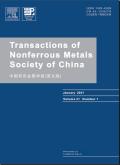Cr和Mg元素微合金化Cu - Ti合金性能增强机理
IF 4.7
1区 材料科学
Q1 METALLURGY & METALLURGICAL ENGINEERING
Transactions of Nonferrous Metals Society of China
Pub Date : 2025-04-01
DOI:10.1016/S1003-6326(24)66745-2
引用次数: 0
摘要
研究了添加Cr和Mg对Cu−Ti合金组织和性能的影响。采用真空感应熔炼法制备了Cu - Ti - Cr - Mg合金。对Cu - Ti - Cr - Mg合金在不同时效状态下的组织和相组成进行了表征。此外,还研究了材料的硬度和电导率。结果表明:Cu - Ti - Cr - Mg合金的析出模式与二元Cu - Ti合金相似,Cr和Ti在铸造过程中形成Cr2Ti金属间化合物;铬和镁的加入提高了合金的硬度。随着Cu - Ti - Cr - Mg合金中Mg含量的增加,Cu - Ti - Cr - Mg合金在时效早期晶粒细化,连续析出相快速形核。此外,Mg的加入通过沿析出相表面的偏析阻碍了不连续析出相的生长。结果表明,Cu−4Ti−0.5Cr−1Mg合金在过时效过程中晶界处出现有限的不连续析出,硬度逐渐下降。本文章由计算机程序翻译,如有差异,请以英文原文为准。
Mechanism of property enhancement of Cu−Ti alloys via microalloying with Cr and Mg elements
The effect of adding Cr and Mg on the microstructure and properties of Cu−Ti alloys was examined. Cu−Ti−Cr−Mg alloys were fabricated using vacuum induction melting. The microstructure and phase composition of Cu−Ti−Cr−Mg alloys in different aging states were characterized. Additionally, the hardness and electrical conductivity of the materials were investigated. Results show that the precipitation pattern in Cu−Ti−Cr−Mg alloys resembled that of binary Cu−Ti alloys, with Cr and Ti forming the intermetallic compound of Cr2Ti during casting. The introduction of Cr and Mg increased the hardness of the alloy. Increasing the Mg content in the Cu−Ti−Cr−Mg alloy led to grain refinement and fast nucleation of continuous precipitates during the early aging stage. Moreover, the addition of Mg impeded discontinuous precipitate growth by segregating along the precipitate surfaces. Consequently, the Cu−4Ti−0.5Cr−1Mg alloy exhibited limited discontinuous precipitates at the grain boundaries and a gradual decline in hardness during the over-aging period.
求助全文
通过发布文献求助,成功后即可免费获取论文全文。
去求助
来源期刊
CiteScore
7.40
自引率
17.80%
发文量
8456
审稿时长
3.6 months
期刊介绍:
The Transactions of Nonferrous Metals Society of China (Trans. Nonferrous Met. Soc. China), founded in 1991 and sponsored by The Nonferrous Metals Society of China, is published monthly now and mainly contains reports of original research which reflect the new progresses in the field of nonferrous metals science and technology, including mineral processing, extraction metallurgy, metallic materials and heat treatments, metal working, physical metallurgy, powder metallurgy, with the emphasis on fundamental science. It is the unique preeminent publication in English for scientists, engineers, under/post-graduates on the field of nonferrous metals industry. This journal is covered by many famous abstract/index systems and databases such as SCI Expanded, Ei Compendex Plus, INSPEC, CA, METADEX, AJ and JICST.

 求助内容:
求助内容: 应助结果提醒方式:
应助结果提醒方式:


